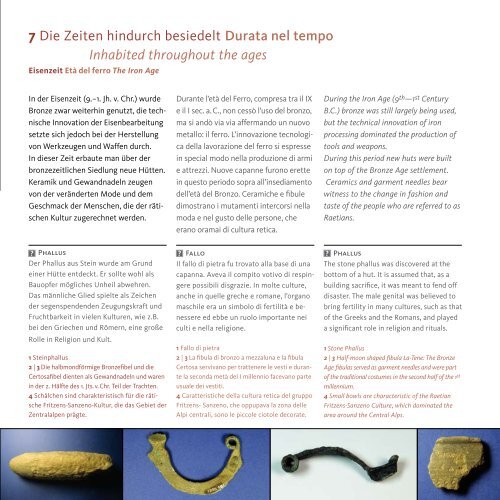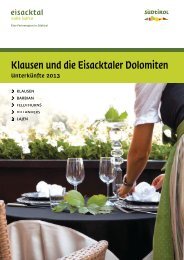Archeoparc Feldthurns Velturno - Provincia Autonoma di Bolzano
Archeoparc Feldthurns Velturno - Provincia Autonoma di Bolzano
Archeoparc Feldthurns Velturno - Provincia Autonoma di Bolzano
You also want an ePaper? Increase the reach of your titles
YUMPU automatically turns print PDFs into web optimized ePapers that Google loves.
7 Die Zeiten hindurch besiedelt Durata nel tempo<br />
Inhabited throughout the ages<br />
Eisenzeit Età del ferro The Iron Age<br />
In der Eisenzeit (9.–1. Jh. v. Chr.) wurde<br />
Bronze zwar weiterhin genutzt, <strong>di</strong>e technische<br />
Innovation der Eisenbearbeitung<br />
setzte sich jedoch bei der Herstellung<br />
von Werkzeugen und Waffen durch.<br />
In <strong>di</strong>eser Zeit erbaute man über der<br />
bronzezeitlichen Siedlung neue Hütten.<br />
Keramik und Gewandnadeln zeugen<br />
von der veränderten Mode und dem<br />
Geschmack der Menschen, <strong>di</strong>e der rätischen<br />
Kultur zugerechnet werden.<br />
Durante l’età del Ferro, compresa tra il IX<br />
e il I sec. a.C., non cessò l’uso del bronzo,<br />
ma si andò via via affermando un nuovo<br />
metallo: il ferro. L’innovazione tecnologica<br />
della lavorazione del ferro si espresse<br />
in special modo nella produzione <strong>di</strong> armi<br />
e attrezzi. Nuove capanne furono erette<br />
in questo periodo sopra all’inse<strong>di</strong>amento<br />
dell’età del Bronzo. Ceramiche e fibule<br />
<strong>di</strong>mostrano i mutamenti intercorsi nella<br />
moda e nel gusto delle persone, che<br />
erano oramai <strong>di</strong> cultura retica.<br />
During the Iron Age (9 th —1 st Century<br />
B.C.) bronze was still largely being used,<br />
but the technical innovation of iron<br />
processing dominated the production of<br />
tools and weapons.<br />
During this period new huts were built<br />
on top of the Bronze Age settlement.<br />
Ceramics and garment needles bear<br />
witness to the change in fashion and<br />
taste of the people who are referred to as<br />
Raetians.<br />
Phallus<br />
Der Phallus aus Stein wurde am Grund<br />
einer Hütte entdeckt. Er sollte wohl als<br />
Bauopfer mögliches Unheil abwehren.<br />
Das männliche Glied spielte als Zeichen<br />
der segenspendenden Zeugungskraft und<br />
Fruchtbarkeit in vielen Kulturen, wie z.B.<br />
bei den Griechen und Römern, eine große<br />
Rolle in Religion und Kult.<br />
1 Steinphallus<br />
2 | 3 Die halbmondförmige Bronzefibel und <strong>di</strong>e<br />
Certosafibel <strong>di</strong>enten als Gewandnadeln und waren<br />
in der 2. Hälfte des 1. Jts. v. Chr. Teil der Trachten.<br />
4 Schälchen sind charakteristisch für <strong>di</strong>e rätische<br />
Fritzens-Sanzeno-Kultur, <strong>di</strong>e das Gebiet der<br />
Zentralalpen prägte.<br />
Fallo<br />
Il fallo <strong>di</strong> pietra fu trovato alla base <strong>di</strong> una<br />
capanna. Aveva il compito votivo <strong>di</strong> respingere<br />
possibili <strong>di</strong>sgrazie. In molte culture,<br />
anche in quelle greche e romane, l’organo<br />
maschile era un simbolo <strong>di</strong> fertilità e benessere<br />
ed ebbe un ruolo importante nei<br />
culti e nella religione.<br />
1 Fallo <strong>di</strong> pietra<br />
2 | 3 La fibula <strong>di</strong> bronzo a mezzaluna e la fibula<br />
Certosa servivano per trattenere le vesti e durante<br />
la seconda metà del I millennio facevano parte<br />
usuale dei vestiti.<br />
4 Caratteristiche della cultura retica del gruppo<br />
Fritzens- Sanzeno, che oppupava la zona delle<br />
Alpi centrali, sono le piccole ciotole decorate.<br />
Phallus<br />
The stone phallus was <strong>di</strong>scovered at the<br />
bottom of a hut. It is assumed that, as a<br />
buil<strong>di</strong>ng sacrifice, it was meant to fend off<br />
<strong>di</strong>saster. The male genital was believed to<br />
bring fertility in many cultures, such as that<br />
of the Greeks and the Romans, and played<br />
a significant role in religion and rituals.<br />
1 Stone Phallus<br />
2 | 3 Half-moon shaped fibula La-Tene: The Bronze<br />
Age fibulas served as garment needles and were part<br />
of the tra<strong>di</strong>tional costumes in the second half of the 1 st<br />
millennium.<br />
4 Small bowls are characteristic of the Raetian<br />
Fritzens-Sanzeno Culture, which dominated the<br />
area around the Central Alps.<br />
43








